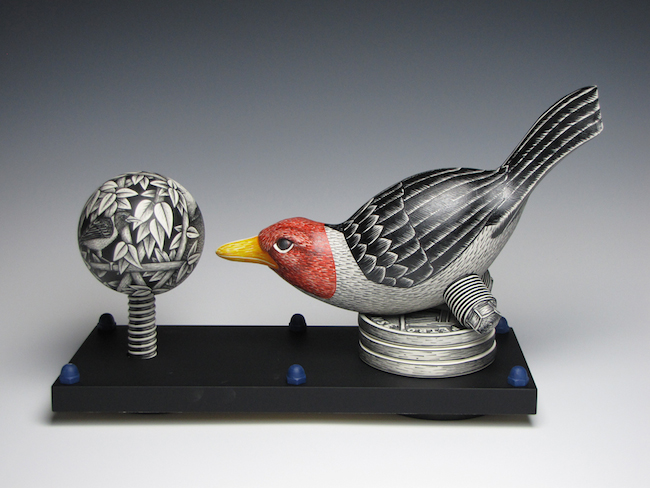It was on the cusp of the present millennium that Jason Walker, represented by Ferrin Comtemporary, came to the attention of ceramic artists and collectors. Two recent shows, a retrospective at the Society for Contemporary Craft (SCC) and a solo exhibition of recent work at the Bellevue Art Museum (BAM), define the artist at a midpoint in his career.
Above image: Jason Walker, Staring Into the Crystal Ball, 2015; porcelain, underglaze china, paint, wood and spray paint, 15 x 10 x 5.5 inches
Since his emergence, Walker has remained in the top tier of a group of artists who have defined a sub-genre of ceramic art with expert optical play between illustrated surface and form. The provenance of this prominence began with thrown and slipcast elements assembled into compact objects based on domestic functional forms. These, in turn, gave way to similarly scaled sculptures, animal or industrial in form, each a canvas for the illustration of its antithesis or a collision between the two.


All of Walker’s works have been explorations in integrating dimensions – in teasing out the tension between the complementarity and contradiction of form and surface – and in the parallel metaphor of nature and technology. These dichotomies continue to define the content of Walker’s art, but revealed in his recent exhibitions is a fully realized transition from pedestal to platform – from singular and self-contained forms to larger-scale, sprawling assemblages of discrete visual components. These new works are a continued development of the micro-environment format, pulpits apropos for the commentative works of this modern-day, Transcendentalist artist.


Jason Walker, Cascade, 2014; porcelain, stoneware, underglaze and china paint
In the expansion of format and the increase in scale, Walker’s inseparable expertise and ostensible eccentricities are all the more evident. On the one hand, with every new element that is introduced (and the growing inventory of trompe l’oeil pipes, bulbs, bolts, and the like runs long in an overview of his works) the artist’s ability to perfectly execute in clay every stirring of his imagination is made clear. In all of these objects and in each illustration, the achievement of fine detail and illusion is counterbalanced by aesthetic choices and subject matter that dispense with pretenses towards hyperrealism and favor the comic, absurd, and surreal. It is in these conjunctions, in these hybridizations of style and in the pairings of patterns, images, and objects that bear a sometimes uneasy referential relation to one another, that the art’s uncanny character is manufactured. And it is the juxtaposition of this uncanniness with the ominous, prophetic musings of the work, grounded in careful consideration and attentive learnedness, which stop the work short of being truly eccentric. It is just on this edge of uncertainty where much of the intrigue with Walker’s art lies, and in his newfound ambition for scale and complexity the artist has taken a bold step closer to this precipice.

Among Walker’s recent, larger-scale sculptures, most are more assemblage than object. This evolving tendency towards delineation and detachment, bound to the artist’s signature juxtapositions of form and image, has led to visually hyper conglomerations. Some of these new works move too rapidly towards a precarious edge between the value of content and visual appeal, and some are milestone successes on both fronts.

Jason Walker, Down the Road (installation at Bellevue Arts Museum), 2014; porcelain, underglaze, china paint

Jason Walker, Infinite Growth, 2013; porcelain, china paint and glaze, 84 x 36 x 3 inches
In one such milestone success, Cascade, Walker has exaggerated the relationship between dimensions to its greatest extent. In this work, by far one of the most ambitious pieces in the show, three-dimensional form now pours, and quite literally so, from headwaters described two-dimensionally, the two worlds almost detaching completely as screws, rods, and bolts spill out into the gallery. Tensely protruding further than ever into the very reality that it critiques, the intrusion is a unique achievement for an artist once inclined towards work that was more intellectually and technically novel than it was physically confrontational. Similarly, the greater demands made upon the viewer in new works like Cascade and Down the Road are evermore incongruent to the politically and morally neutral persona that the artist has sought to maintain. Indeed, as Walker’s work now encroaches further upon our senses and thus confronts our consciences more forcibly, contrasting images of the reluctant observer and the proselytizing activist recede into the conflicting realities that define the artist and his work.
Anthony Stellaccio is a writer and artist.
Love contemporary ceramic art? Let us know in the comments.



Jason Walker, Wildflowers, 2015; porcelain, stoneware, china paint, wood and spray paint 23 x 20 x 20 inches. Photographs courtesy of Ferrin Contemporary.

Add your valued opinion to this post.